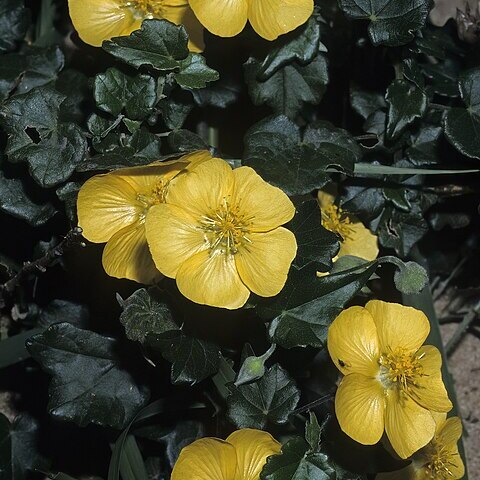Leaf-lamina 1–4 (6) × 0·75–3 (5) cm., thin but firm, usually triangular-cordate with broadly rounded basal lobes and abruptly acuminate into a long narrowly-triangular acumen (often with lobules at the base of the acumen and the lamina thus appearing 3-lobed), sometimes ovate-cordate or cordate-triangular, margin varying from subentire or sinuous to ± crenate or bluntly and occasionally coarsely dentate, often discolorous but sometimes lower surface only slightly paler, upper surface dark greyish-green to brown, very shortly velutinous and smooth or with additional coarse stellate hairs, glabrescent, lower surface paler to almost ash-grey or white, velutinous; petiole slender, longer or shorter than the lamina, more or less densely stellate-pubescent, sometimes somewhat viscid and often with pilose hairs at the apex (if so, often also long hairs on veins near leaf-base on lower surface).
Perennial (biennial) shrublet, 1.0-1.5 m high; stems slender, purplish brown. Leaves comparatively small, triangular-cordate, apex abruptly acuminate, margins ± crenate; dark greyish green and shortly velutinous above, ash-grey or white and velutinous below; petioles slender, densely stellate-pubescent, apex pilose. Flowers axillary, solitary; pedicels slender, often longer than leaves, articulated. Calyx cupuliform, lobes ovate. Petals yellow. Staminal tube stellate-hirsute. Flowering time Sept.-Mar. Fruit hemispherical. Mericarps 10-20, blackish, much-compressed, papery, 10-11 x 8-9 mm, somewhat convex at slanting apical side, forming sharp point or subulate awn up to 3 mm long, ventral tooth not upcurved. Seeds finely verrucose-papillose.
Perennial or biennial shrublet up to 1 (1–5) m. tall; stems slender, tough when young, somewhat angular or sulcate, soon terete, covered with a short stellate-tomentose, floccose or scabridulous but not velvety indumentum, sometimes somewhat glandular-viscid on the young parts, glabrescent, greyish usually turning brown to purplish-brown or almost black, ultimately woody and marked with longitudinal short shallow grooves.
Mericarps 10–20, 10–11 × 8–9 mm., much compressed, papery, 2–3-seeded, obliquely truncate to somewhat convex at the slanting apical side and produced at the outer angle into a sharp point or a subulate awn up to 3 mm. long.
Calyx grey-green, velutinous-tomentose; tube 3–4 mm. long and 6–7 mm. in diam. at the apex, cupuliform; lobes 5–7 × 3–4 mm., ovate-or oblong-elliptic to elliptic, subacute, minutely apiculate.
Pedicels on main shoots, slender, generally much longer than the petioles and often exceeding the leaves, finely stellate-pubescent, articulated in upper 10 mm.
Fruit c. 12 × 18 mm., hemispherical, umbilicate-truncate, finely stellate-pubescent.
Seeds c. 2–5 × 2 mm., dark brown, minutely verrucose-papillose.
Petals 11–13 mm. long, yellow, glabrous except at the base.
Staminal tube stellate-hirsute.

